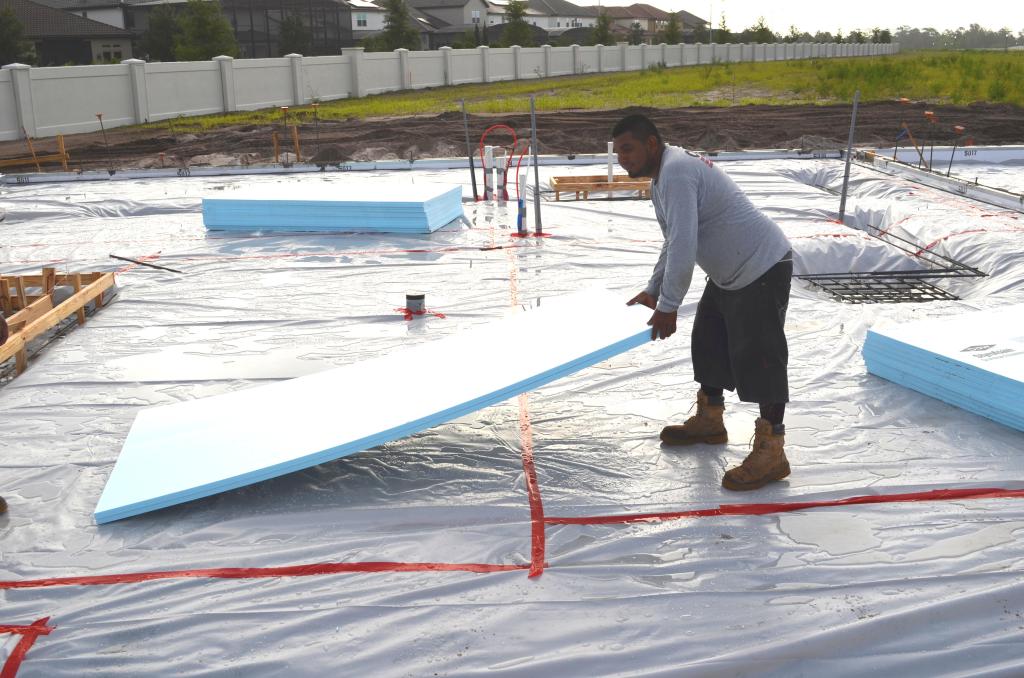Some processes rarely improve over time. Making a pizza, for instance. The best pizzas are made just like the ones that were made 100 years ago.
But that doesn’t mean we haven’t tried to improve on the process. We can microwave a pizza quickly, but the wood-fired brick oven has returned to popularity. Why? Because it’s the best.
With building homes, so much of the process has remained the same for centuries. While some of the processes have been questioned and/or altered, the results are mixed, with some efforts resulting in a step backward in the final product.
With the reNEWable Living Home, Meritage Homes is going back 60 years in home building to renew a process that performs more effectively and doesn’t cost any more to add: insulated slabs.
Builders used to build super-efficient slabs that were able to create a thermal break between the surface temperature and the slab with footer walls in order to create a more comfortable and regulated environment inside the home. When air conditioning became popular and it became easier to cool or heat the home with slab-on-grade construction, insulated slabs went to the wayside.
The Uninsulated Truth on Energy Performance
However, when concrete and flooring are one-sixth the external surface of the house, it’s important to consider what that’s doing to the performance of the home. CR Herro, vice president of environmental affairs at Meritage Homes, is heading up the return to insulated slabs for the reNEWable Living Home.
“The slab can contribute to 40% of the energy loss in a normal home,” he says. “By insulating it, we can eliminate 80% of edge and ground effects. In our home, we will go from 40% to 8% gain/loss through the slab.”
Here he explains more of the process and why this transition is important to the future of sustainable homes.
The ground surface can be 140 degrees when it heats up. That ground is right next to a slab that the homeowner is trying to keep to a comfortable 78 degrees inside the home. What we know about concrete is that it conducts heat really well, and it can store heat really well. So, there ends up being a battle in efficiency when the surface ground is soaking up the sun’s rays and transferring that heat through the slab, which then comes in contact with the interior environment.
In the summer time, when the home is trying to remain cool, the air conditioning has to run overtime to mitigate the heat that is being conducted inside via the slab. In the winter, the opposite happens. In the case of an uninsulated slab, the concrete that is in contact with the freezing cold ground loses the heat that the home’s heating system is trying so hard to produce.

Installing the underslab insulation takes very little time and offers a big payback.
Obviously, this detracts from energy bills and comfort, Herro says. In different areas of the country, this will have a different impact. The more that the temperature varies from the comfort zone at 78 degrees, it’s that much more important. So, insulating a slab is not as critical in San Diego as it is in, say, Texas or Florida.
“With the reNEWable Living Home, we are going back to less dependence on mechanical heating and cooling through an insulated slab,” Herro explains. “We are going to insulate all the way around the slab so that concrete no longer acts to conduct heat. It acts as an insulator. This will show a dramatic change in the ability to keep the home comfortable.”
Breaking Even
The cost of building the home better is amortized across the life of the home and its better performance. There is an upfront cost to putting in the insulation, however, over time it can save more than that initial cost as seen in monthly heating and cooling bills.
“As usual, it pays for you to build your home better,” Herro says. “Buyers see the cost, but they don’t understand the savings, which is the test for all good energy efficiency features. If they can demonstrate that they reduce your average monthly operating costs more than the cost to the mortgage payment, then it’s a good improvement.”
Adding Slab Insulation to the Process
With higher energy performance and cost savings, there have to be challenges to the installation process, right? Herro explains that although the process is different, it doesn’t add time and it can offer several benefits.
Normally, the slab can be poured in one day and then is left to cure for a few days. In this process, the footers would be poured, followed by the internal slab. Herro explains that it can be the same amount of time or a couple of additional days, depending on when you choose to pour the internal slab.
The first benefit that this can offer is that the builder can pour the internal slab at a different time of construction, which offers more flexibility in the process to do stained or printed concrete above grade.
Insulated slabs also have deeper footer systems than a conventional slab. This can be a huge benefit in places with expanding soil. The deeper footers mean that there is less lateral water movements beneath the slab, which reduces soil swells.
Redirecting the Industry
Just as many American franchises are trying to revive the authentic process of pizza making, Meritage Homes is renewing the process of home building. And, what’s important to Meritage is that the industry benefits.
When home building can be improved, it should be shared. In this case, adding slab insulation is a minimal cost and a minimal impact to the construction schedule, yet it offers many benefits. Herro says this is one of several opportunities for conventional home building to be renewed.
Make plans to see the reNEWable Living Home on display in Orlando in January 2018. Plus, you can follow the development of the home at www.builderonline.com/renewable.



